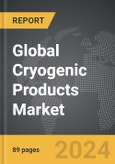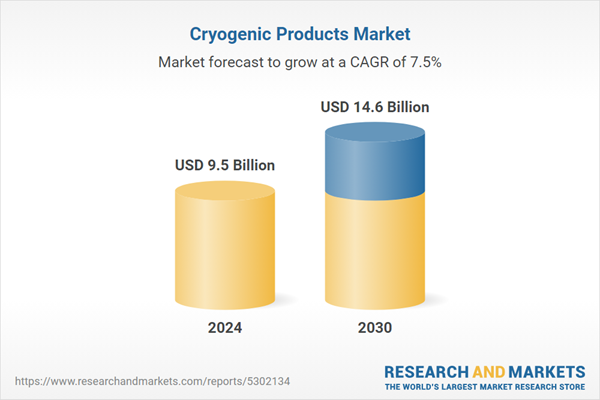The global market for Cryogenic Products was valued at USD 9.5 Billion in 2024 and is projected to reach USD 14.6 Billion by 2030, growing at a CAGR of 7.5% from 2024 to 2030. This comprehensive report provides an in-depth analysis of market trends, drivers, and forecasts, helping you make informed business decisions.
Global Cryogenic Products Market - Key Trends and Drivers Summarized
What Are Cryogenic Products and Why Are They Vital for Scientific and Industrial Applications?
Cryogenic products refer to equipment, materials, and technologies used to achieve, maintain, and manipulate extremely low temperatures, typically below -150°C (-238°F). These products play a critical role in various scientific, industrial, and medical fields, enabling the storage, transportation, and handling of cryogenic substances like liquid nitrogen, helium, and hydrogen. Common cryogenic products include cryogenic storage tanks, dewars, cryocoolers, cryogenic freezers, and insulated pipelines designed to maintain the ultra-cold environments needed to preserve biological samples, supercool electronic components, or store liquefied gases for energy applications. Cryogenics is indispensable in sectors such as healthcare, where cryogenic freezers preserve biological samples like stem cells, organs, and vaccines; in the aerospace and defense industries, where cryogenic fuels are used to power rockets and spacecraft; and in the energy sector, where liquefied natural gas (LNG) is stored and transported at cryogenic temperatures to minimize volume. These products are engineered to withstand extreme thermal stresses, maintain temperature stability, and ensure safe handling of volatile and highly pressurized substances. As a result, cryogenic products are not only central to critical applications but also form the backbone of modern technological advancements that require precise temperature control and stability.How Are Cryogenic Products Evolving to Meet Modern Demands and Standards?
The design and functionality of cryogenic products have evolved significantly to meet the growing demands for safety, efficiency, and reliability across various industries. One major trend is the development of advanced insulation technologies that minimize heat transfer and ensure temperature stability over long periods. Vacuum-insulated panels, multi-layer insulation, and aerogel-based materials are increasingly being used in cryogenic storage tanks and pipelines to reduce thermal losses and improve energy efficiency. Additionally, manufacturers are focusing on the miniaturization and optimization of cryogenic equipment, such as compact cryocoolers and micro-sized dewars, to cater to applications with space and weight constraints, such as in satellite technology and portable medical devices. Another key advancement is the integration of smart monitoring systems, which use sensors and IoT technologies to provide real-time data on temperature, pressure, and liquid levels. These systems enable predictive maintenance, automatic adjustments, and remote monitoring, enhancing both operational safety and performance. In the healthcare and research sectors, cryogenic freezers and storage systems are being designed with enhanced sample management capabilities, including barcode tracking, digital inventory systems, and temperature uniformity features that ensure the integrity of stored specimens. Furthermore, the shift towards sustainable and environmentally friendly solutions is influencing the development of cryogenic products, leading to the use of more energy-efficient cryogenic refrigeration systems and the adoption of alternative refrigerants with lower global warming potential (GWP).What Technological Breakthroughs Are Defining the Future of Cryogenic Products?
The future of cryogenic products is being shaped by a wave of technological innovations that are enhancing their efficiency, versatility, and environmental impact. One of the most significant breakthroughs is the use of cryogenic 3D printing, which enables the fabrication of complex cryogenic components with intricate internal structures that optimize thermal management and reduce material usage. This technology is transforming the production of custom cryogenic equipment, such as heat exchangers and storage vessels, offering unprecedented design flexibility and performance optimization. Another major advancement is in the development of high-temperature superconductors (HTS) that operate at cryogenic temperatures but offer much higher efficiency and lower power consumption compared to conventional superconductors. HTS materials are paving the way for more compact and powerful cryogenic systems used in applications such as MRI machines, particle accelerators, and quantum computing. Additionally, innovations in cryogenic fluid handling, such as non-invasive flow meters and ultra-sensitive pressure regulators, are improving the safety and accuracy of cryogenic systems, enabling precise control over the storage and transfer of cryogenic liquids. The integration of AI and machine learning into cryogenic monitoring systems is another groundbreaking trend, allowing these systems to predict and prevent failures by analyzing large datasets and optimizing operational parameters in real-time. Furthermore, advancements in cryogenic cooling technologies, such as pulse-tube and Stirling coolers, are providing more efficient and compact solutions for applications that require localized cooling, such as in aerospace, electronics, and deep-space exploration.What Factors Are Driving the Growth of the Cryogenic Products Market?
The growth in the cryogenic products market is driven by several key factors, including the rising demand for liquefied natural gas (LNG), the expanding use of cryogenics in healthcare and life sciences, and the increasing adoption of cryogenic technologies in emerging industries such as quantum computing and aerospace. One of the primary drivers is the growing LNG market, as cryogenic products are essential for the storage, transport, and regasification of natural gas. The global push towards cleaner energy sources has led to increased investment in LNG infrastructure, boosting demand for cryogenic tanks, pumps, and pipelines. In the healthcare and life sciences sectors, the need for ultra-low temperature storage solutions has surged due to advancements in cellular therapy, biobanking, and vaccine development, creating a robust market for cryogenic freezers and cryostats. Additionally, the advent of quantum computing and the expanding field of superconductivity research are driving demand for specialized cryogenic systems that can maintain stable, ultra-cold temperatures required for quantum devices and superconducting circuits to function. The aerospace and defense sectors are also contributing to market growth, as cryogenic products are used extensively in rocket propulsion systems and space exploration missions, where precise temperature control is critical for fuel management and structural integrity. Moreover, the trend towards digitalization and the integration of smart technologies is enhancing the functionality and appeal of cryogenic products, as industries seek advanced monitoring, automation, and safety features. With these factors converging, the cryogenic products market is poised for significant expansion, driven by technological advancements and the growing need for efficient, reliable, and sustainable cryogenic solutions across multiple industries.Report Scope
The report analyzes the Cryogenic Products market, presented in terms of market value (USD Thousand). The analysis covers the key segments and geographic regions outlined below.Segments
Segment (Cryogenic Products).Geographic Regions/Countries
World; United States; Canada; Japan; China; Europe (France; Germany; Italy; United Kingdom; Spain; Russia; and Rest of Europe); Asia-Pacific (Australia; India; South Korea; and Rest of Asia-Pacific); Latin America (Argentina; Brazil; Mexico; and Rest of Latin America); Middle East (Iran; Israel; Saudi Arabia; United Arab Emirates; and Rest of Middle East); and Africa.Regional Analysis
Gain insights into the U.S. market, valued at $2.5 Billion in 2024, and China, forecasted to grow at an impressive 11% CAGR to reach $3.5 Billion by 2030. Discover growth trends in other key regions, including Japan, Canada, Germany, and the Asia-Pacific.Report Features:
- Comprehensive Market Data: Independent analysis of annual sales and market forecasts in USD from 2024 to 2030.
- In-Depth Regional Analysis: Detailed insights into key markets, including the U.S., China, Japan, Canada, Europe, Asia-Pacific, Latin America, Middle East, and Africa.
- Company Profiles: Coverage of major players such as Acme Cryogenics, Air Products, Applied Cryotechnology, Beijing Tianhai Cryogenic Equipment, Chart Industries and more.
- Complimentary Updates: Receive free report updates for one year to keep you informed of the latest market developments.
Why You Should Buy This Report:
- Detailed Market Analysis: Access a thorough analysis of the Global Cryogenic Products Market, covering all major geographic regions and market segments.
- Competitive Insights: Get an overview of the competitive landscape, including the market presence of major players across different geographies.
- Future Trends and Drivers: Understand the key trends and drivers shaping the future of the Global Cryogenic Products Market.
- Actionable Insights: Benefit from actionable insights that can help you identify new revenue opportunities and make strategic business decisions.
Key Questions Answered:
- How is the Global Cryogenic Products Market expected to evolve by 2030?
- What are the main drivers and restraints affecting the market?
- Which market segments will grow the most over the forecast period?
- How will market shares for different regions and segments change by 2030?
- Who are the leading players in the market, and what are their prospects?
Some of the 34 major companies featured in this Cryogenic Products market report include:
- Acme Cryogenics
- Air Products
- Applied Cryotechnology
- Beijing Tianhai Cryogenic Equipment
- Chart Industries
- Cryofab
- Cryogas Industries
- Cryoquip
- Cryostar
- Emerson
- Flowserve Corporation
- Herose GmbH
- Inoxcva
- Linde Plc
- Meyer Tools
- Parker Hannifin
- Shell-N-Tube
- Shengjie Cryogenic Equipment Public Limited Company
- Taylor-Wharton
- Wessington Cryogenics
Table of Contents
I. METHODOLOGYII. EXECUTIVE SUMMARY2. FOCUS ON SELECT PLAYERSIII. MARKET ANALYSISIV. COMPETITION
1. MARKET OVERVIEW
3. MARKET TRENDS & DRIVERS
4. GLOBAL MARKET PERSPECTIVE
UNITED STATES
CANADA
JAPAN
CHINA
EUROPE
FRANCE
GERMANY
ITALY
UNITED KINGDOM
SPAIN
RUSSIA
REST OF EUROPE
ASIA-PACIFIC
AUSTRALIA
INDIA
SOUTH KOREA
REST OF ASIA-PACIFIC
LATIN AMERICA
ARGENTINA
BRAZIL
MEXICO
REST OF LATIN AMERICA
MIDDLE EAST
IRAN
ISRAEL
SAUDI ARABIA
UNITED ARAB EMIRATES
REST OF MIDDLE EAST
AFRICA
Companies Mentioned (Partial List)
A selection of companies mentioned in this report includes, but is not limited to:
- Acme Cryogenics
- Air Products
- Applied Cryotechnology
- Beijing Tianhai Cryogenic Equipment
- Chart Industries
- Cryofab
- Cryogas Industries
- Cryoquip
- Cryostar
- Emerson
- Flowserve Corporation
- Herose GmbH
- Inoxcva
- Linde Plc
- Meyer Tools
- Parker Hannifin
- Shell-N-Tube
- Shengjie Cryogenic Equipment Public Limited Company
- Taylor-Wharton
- Wessington Cryogenics
Table Information
| Report Attribute | Details |
|---|---|
| No. of Pages | 89 |
| Published | March 2025 |
| Forecast Period | 2024 - 2030 |
| Estimated Market Value ( USD | $ 9.5 Billion |
| Forecasted Market Value ( USD | $ 14.6 Billion |
| Compound Annual Growth Rate | 7.5% |
| Regions Covered | Global |









